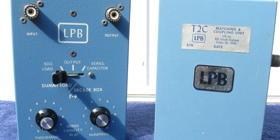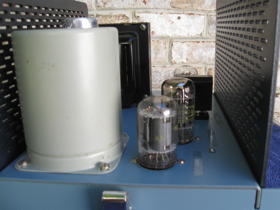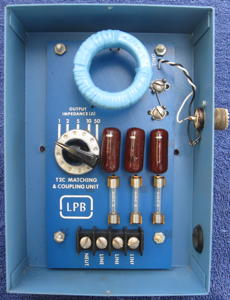Vintage Audio: LPB Carrier Current AM Transmitter | Telos Alliance
By The Telos Alliance Team on Feb 12, 2014 2:21:00 PM
 Vintage Audio: LPB Carrier Current AM Transmitter
Vintage Audio: LPB Carrier Current AM Transmitter
An often-overlooked facet of AM broadcasting is carrier current radio. Typically carrier current is implemented by feeding the RF signal into the AC power distribution system of building allowing for broadcasting over limited areas. Hence, its widespread use among student-run college radio stations.
This month's trip to the attic turned up a dusty but functional LPB RC-6A carrier current transmitter, along with its coupler and test gear.
The origins of carrier current go back to the 1930s, when the technology was used by the phone company to send RF over phone lines. Part 15 of the FCC Rules originated in 1938, to allow the operation of wireless phonograph oscillators in homes, with the stipulation that it would not interfere with licensed broadcasters. Students at Brown University used the Part 15 Rules as a framework to build a campus radio station, feeding the RF signal into power lines in the dormitories. Word quickly spread, and many colleges and universities started their own stations.
At first, carrier current broadcasters had to build their own transmitters, as this niche market was way too small for industry giants like RCA, Gates or Raytheon to bother with. In 1960, Dick Crompton founded LPB, Inc., and began to manufacture carrier current transmitters and related equipment for college broadcasters. The company was a huge success, due in large part to the simple-but elegant circuitry and battleship-quality construction of its gear.
This RC-6A had an output of about 5 watts, enough to cover a large dormitory.
So, radio geeks - how does carrier current radio work?
The circuitry was designed around the 6AL11 This was a dual-stage Compactron tube, part of a family of devices developed by General Electric for portable televisions.
 The RF section consisted of a single 6AL11. The first half was used as an electron-coupled oscillator, while the second was the output stage, with a pi-network to connect the transmitter to the T2C coupler. A neon bulb was used to tune the transmitter for maximum RF output.
The RF section consisted of a single 6AL11. The first half was used as an electron-coupled oscillator, while the second was the output stage, with a pi-network to connect the transmitter to the T2C coupler. A neon bulb was used to tune the transmitter for maximum RF output.
The audio section had two 6AL11s, configured as a balanced modulator. The input stage received audio through a UTC line-to-grid matching transformer, while a UTC CVM-0 was employed as the modulation transformer.
Pictured with the RC-6A are the T2C coupling unit and T-4 decade box, essential components of the carrier current system. The T2C matched the 50-ohm output of the transmitter to the (usually) much lower impedance of the power line, and also isolated the RF output from the AC line. Impedance matching was accomplished by switch-selected taps on a toroid transformer and insertion of a series capacitor. The output of the T2C was usually connected to all phases of a building's AC service through a 4-prong plug and mating socket connected to the main breaker panel. 3-amp fast blow fuses provided the last line of defense.
The T-4 made fast work of selecting the right value of series capacitor when installing transmitters and checking AC loads. The unit was placed in series with the RF output, and decade knobs adjusted for the best impedance match, usually indicated by a dip in plate current or peak in the neon RF indicator.
 Installing and maintaining a reliable carrier current system could be a challenge. AC loads in the dormitories changed as a function of how many lights and other devices were switched on. Since college stations had most of their listenership in the evening hours, that was the time to optimize the settings in the coupler. Any stray AC that found its way back into the transmitter would manifest itself as hum on the AM signal, particularly with the older vacuum tube transmitters. Equipment was often located in blisteringly hot and dirty boiler rooms, leading to frequent failures and an annual routine of changing out tubes and electrolytic capacitors. Since high-quality audio transformers were expensive, many stations shunned equalized lines from the phone company in favor of unbalanced audio distribution systems, creating another source of hum.
Installing and maintaining a reliable carrier current system could be a challenge. AC loads in the dormitories changed as a function of how many lights and other devices were switched on. Since college stations had most of their listenership in the evening hours, that was the time to optimize the settings in the coupler. Any stray AC that found its way back into the transmitter would manifest itself as hum on the AM signal, particularly with the older vacuum tube transmitters. Equipment was often located in blisteringly hot and dirty boiler rooms, leading to frequent failures and an annual routine of changing out tubes and electrolytic capacitors. Since high-quality audio transformers were expensive, many stations shunned equalized lines from the phone company in favor of unbalanced audio distribution systems, creating another source of hum.
Eventually, carrier current went the way of all AM. When the Class D revolution came in the early 1970s, many college stations dumped their low-power AM systems and purchased 10-watt FM transmitters. A few larger college stations kept AM as a training facility, and with solid-state transmitters, a few held on till the late 80s. By then, the migration to FM was complete, and student interest in AM radio had bottomed out. Carrier current systems are still used to provide sound at drive-in movie theaters and for traveller's information systems. Slotted coax is often used as the antenna.
This particular unit was built in October 1969, and gave reliable service to a college broadcaster for about 15 years. It was saved from a dumpster when the station upgraded to solid-state transmitters in the mid-1980s. With a fresh set of 6AL11s, this restored RC-6A meets original specs and sounds great, 44 years after it rolled out of the factory in Malvern, PA.
Do any of our readers remember carrier current at their college? Or perhaps you listened to carrier current on the AM radio of your car at a drive-in movie?
Telos Alliance has led the audio industry’s innovation in Broadcast Audio, Digital Mixing & Mastering, Audio Processors & Compression, Broadcast Mixing Consoles, Audio Interfaces, AoIP & VoIP for over three decades. The Telos Alliance family of products include Telos® Systems, Omnia® Audio, Axia® Audio, Linear Acoustic®, 25-Seven® Systems, Minnetonka™ Audio and Jünger Audio. Covering all ranges of Audio Applications for Radio & Television from Telos Infinity IP Intercom Systems, Jünger Audio AIXpressor Audio Processor, Omnia 11 Radio Processors, Axia Networked Quasar Broadcast Mixing Consoles and Linear Acoustic AMS Audio Quality Loudness Monitoring and 25-Seven TVC-15 Watermark Analyzer & Monitor. Telos Alliance offers audio solutions for any and every Radio, Television, Live Events, Podcast & Live Streaming Studio With Telos Alliance “Broadcast Without Limits.”
Recent Posts
Subscribe
If you love broadcast audio, you'll love Telos Alliance's newsletter. Get it delivered to your inbox by subscribing below!